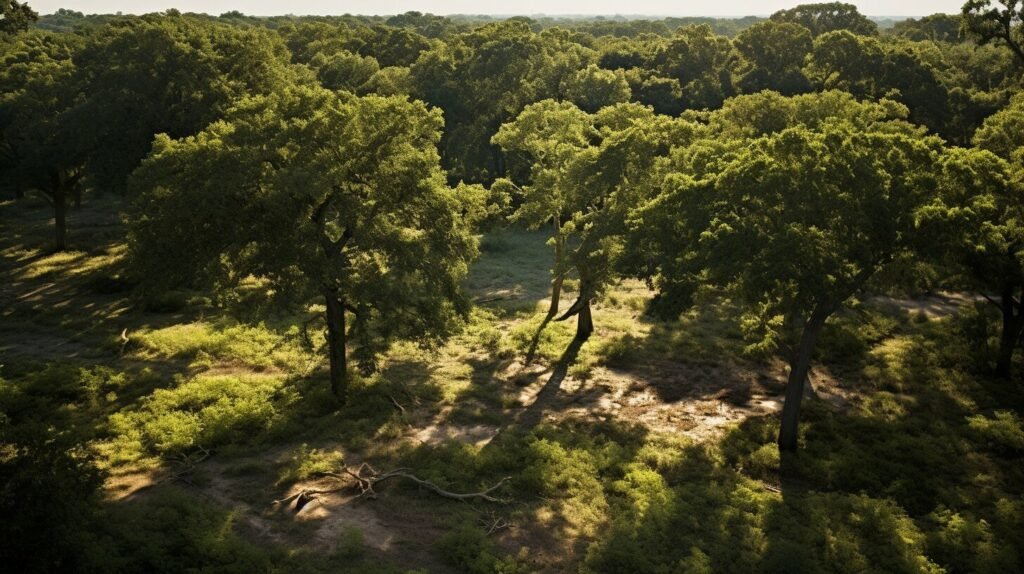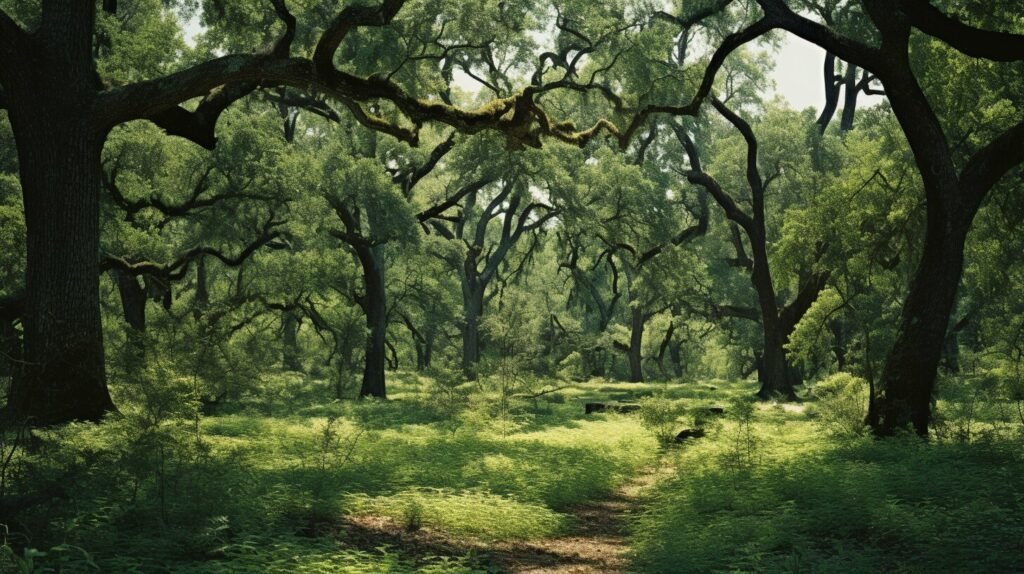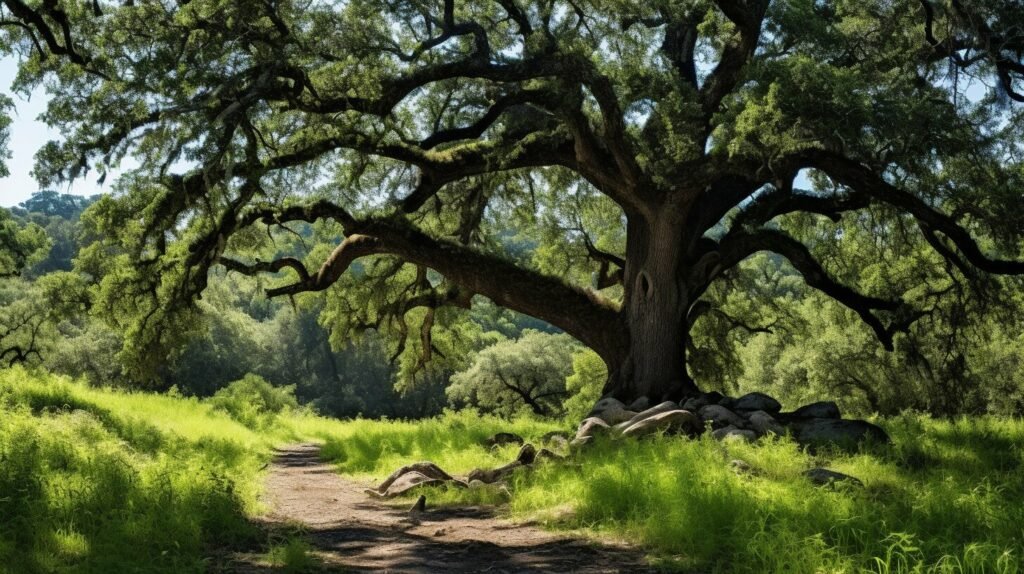Oak trees are vital to forest ecosystems, serving as keystone species and playing a crucial role in maintaining the balance of nature. They have dominated central hardwood forests for thousands of years, contributing to the rich biodiversity found in these areas. Through their canopy, oak trees provide food, shelter, and support for numerous wildlife species, creating a diverse herbaceous understory. In addition to their ecological importance, oak trees also have significant cultural and economic significance.
- Oak trees are keystone species in forest ecosystems, contributing to biodiversity and supporting a wide range of flora and fauna.
- Oak and hickory dominance creates a diverse herbaceous understory, providing food and habitat for wildlife.
- The decline of oak woodlands can have negative economic impacts, affecting industries that rely on oak timber.
- Oak trees help stabilize soil, improve fertility, protect groundwater quality, and reduce soil erosion.
- Oak trees sequester carbon, improving air quality and helping mitigate the effects of global warming.
As we delve into the topic of oak trees and their significance in forest ecosystems, we will explore the diversity of oak tree ecosystems, their role in soil enrichment, their contribution to wildlife support, and their impact on climate. We will also take a closer look at the unique oak tree ecosystems found in California and highlight the economic and cultural implications of these majestic trees. Additionally, we’ll examine the importance of acorns as a traditional food source and their nutritional value. By the end of this article, you’ll have a comprehensive understanding of the crucial role oak trees play in forest ecology.
The Diversity of Oak Tree Ecosystems
Oak tree ecosystems are teeming with life, supporting a diverse array of plants and animals that thrive in the shade of their majestic canopies. These ecosystems are home to a rich biodiversity, creating a vibrant and complex web of life. Underneath the towering oaks, a diverse herbaceous understory flourishes, providing a habitat for a multitude of understory plants.
Flourishing under the canopy of oak and hickory trees, the understory of oak tree ecosystems boasts an incredible variety of plant species. From delicate wildflowers to resilient ferns, the understory plants contribute to the ecosystem’s overall biodiversity by providing a wide range of food sources, shelter, and resources for other organisms. This diverse understory is a testament to the interconnectedness of life within oak tree ecosystems.
The biodiversity of oak tree ecosystems extends beyond the plant life. These ecosystems are home to a myriad of animal species, ranging from small insects to larger mammals. The fallen acorns and leaf litter from oak trees provide a vital food source for many animals, attracting a diverse array of wildlife. Squirrels and other small mammals rely on acorns as a primary food source, while birds, such as woodpeckers and jays, play a crucial role in dispersing acorns and aiding in the regeneration of oak tree populations.
To truly appreciate the biodiversity and ecological importance of oak tree ecosystems, one must venture into their midst. It is within these diverse and interconnected ecosystems that the intricate balance of nature unfolds, supporting countless organisms and providing a haven for both plant and animal life. The beauty and complexity of oak tree ecosystems serve as a reminder of the wonders of our natural world and the crucial role that each species plays in maintaining its delicate balance.
The Understory Plants of Oak Tree Ecosystems
To better understand the incredible diversity of understory plants in oak tree ecosystems, let’s take a closer look at some of the notable species:
| Plant Species | Description |
|---|---|
| Trillium grandiflorum | A stunning perennial wildflower with large white flowers and three leaves, commonly known as the white trillium. |
| Asarum canadense | Also known as Canadian wild ginger, this low-growing herb has heart-shaped leaves and produces inconspicuous but fragrant flowers. |
| Athyrium filix-femina | A graceful fern species that thrives in the moist and shady conditions of oak tree ecosystems, known as the lady fern. |
| Sanguinaria canadensis | Commonly referred to as bloodroot, this perennial herb gets its name from its red sap and produces beautiful white flowers. |
| Dicentra cucullaria | A delicate spring ephemeral with unique heart-shaped leaves and white flowers, commonly called Dutchman’s breeches. |
These are just a few examples of the incredible diversity of understory plants that thrive in oak tree ecosystems. Each species plays a unique role in the ecosystem, contributing to the overall health and resilience of this remarkable habitat.

As we explore the diverse and intricate world of oak tree ecosystems, it becomes clear that these magnificent trees are far more than just a beautiful part of our natural landscapes. They are vital contributors to biodiversity, supporting countless plant and animal species, and providing essential resources for a thriving ecosystem. Oak tree ecosystems are a testament to the interconnectedness of life and the remarkable resilience of nature.
Oak Trees and Soil Enrichment
Oak trees are nature’s soil builders, enhancing soil fertility and stability through their extensive root systems and organic matter deposition. Their deep-reaching roots help to break up compacted soil, improving its structure and allowing for better water and nutrient absorption. As these roots grow, they create channels for water to flow, preventing soil erosion and reducing the risk of runoff.
Not only do oak trees stabilize the soil physically, but they also enrich it chemically. The fallen leaves, twigs, and acorns from oak trees decompose over time, releasing essential nutrients back into the soil. This process, known as organic matter deposition, improves soil fertility and provides a nutrient-rich environment for other plant species to thrive. The organic matter acts as a natural fertilizer, promoting the growth of beneficial microorganisms that further enhance soil health.
| Benefits of Oak Trees for Soil Enrichment: |
|---|
| Enhanced soil fertility |
| Improved water and nutrient absorption |
| Prevention of soil erosion |
| Promotion of beneficial microorganisms |
The contribution of oak trees to soil enrichment is particularly important in areas where the soil is nutrient-poor or prone to erosion. By improving the soil’s quality and stability, oak trees create a favorable environment for other plant species to grow and thrive.

“The organic matter deposition from oak trees is like a natural elixir for the soil. It replenishes the nutrients and provides a nurturing habitat for the underground ecosystem, creating a healthy foundation for the entire forest.” – Dr. Emily Anderson, Soil Scientist
The Role of Acorns in Oak Tree Ecosystems
In addition to their soil-building capabilities, oak trees produce acorns, which play a vital role in their ecosystem. Acorns serve as a significant source of food for many wildlife species, including squirrels, birds, deer, and even some insects. These animals rely on acorns as a primary food source, especially during the autumn months when other food may become scarce.
To unlock the nutritional potential of acorns, various indigenous communities have developed processing techniques. These methods involve leaching the acorns to remove bitter and tannic compounds and then grinding them into flour, which can be used to make traditional foods such as bread, porridge, and cakes. The processing of acorns not only provides sustenance but also preserves cultural practices and strengthens the connection between indigenous communities and oak trees.
- Acorns are a vital food source for wildlife.
- The processing of acorns plays a crucial role in indigenous cultures.
- Acorn flour is used to make traditional foods.
Overall, oak trees contribute significantly to soil enrichment, stability, and fertility. Their deep roots, organic matter deposition, and the provision of acorns create a robust ecosystem that supports a diverse range of flora and fauna. By recognizing and appreciating the important role that oak trees play, we can strive to conserve and protect these magnificent trees for future generations.
Oak Trees and Wildlife Support
Oak tree ecosystems are nature’s supermarkets, offering an abundance of food and shelter for a diverse array of wildlife, from birds and squirrels to deer and bears. These majestic trees provide essential resources that support the survival and thriving of numerous animal species.
The oak and hickory dominance in these ecosystems creates a favorable environment for a rich biodiversity. Underneath their canopies, a diverse herbaceous understory thrives, providing additional food sources and hiding spots for smaller animals. The fallen acorns, known as mast, serve as a staple food for many wildlife species, including rodents, birds, and even larger mammals like deer and bears.

In addition to food, oak trees offer shelter and nesting sites for various birds, such as woodpeckers and owls. The complex structure of their branches and foliage provides safe havens for squirrels and other arboreal creatures, while the hollows in older oak trees become homes for raccoons, bats, and other cavity-nesting animals.
Oak Trees and Wildlife Conservation
The importance of oak tree ecosystems for wildlife conservation cannot be overstated. They play a vital role in maintaining healthy populations of animals and contributing to the overall biodiversity of forest ecosystems. Protecting and preserving these habitats is crucial for the long-term survival of many wildlife species.
By understanding the significance of oak trees as wildlife habitats and food sources, we can work towards their conservation and ensure the continued existence of these invaluable ecosystems.
| Key Wildlife Supported by Oak Trees | Food Sources | Shelter and Nesting Sites |
|---|---|---|
| Squirrels | Acorns, nuts, seeds | Hollow tree branches, tree cavities |
| Deer | Acorns, browse plants | Understory vegetation, fallen logs |
| Birds (woodpeckers, owls, etc.) | Insects, nuts, seeds | Tree branches, tree cavities |
| Raccoons | Acorns, berries, small mammals | Hollow tree trunks, dens |
These examples represent just a fraction of the wildlife that depends on oak tree ecosystems. Their interconnectedness with the surrounding environment highlights the importance of preserving these habitats to ensure the survival of numerous species and maintain the delicate balance of forest ecosystems.
Oak Trees and Climate Impact
Oak trees are environmental superheroes, actively capturing and storing carbon dioxide, thereby combating climate change and improving the air we breathe. As key components of oak tree ecosystems, these mighty trees play a crucial role in carbon sequestration and air quality improvement.
Through a process called photosynthesis, oak trees absorb carbon dioxide from the atmosphere and convert it into oxygen. In fact, a single mature oak tree can absorb up to 48 pounds of carbon dioxide per year. This carbon sequestration helps to reduce the greenhouse effect and mitigate global warming, making oak trees valuable allies in the fight against climate change.
Not only do oak trees sequester carbon, but their presence also enhances air quality. The leaves of oak trees act as natural filters, trapping pollutants and particulate matter in the air. This filtering capacity is especially significant in urban areas, where air pollution levels are often higher. By improving air quality, oak trees contribute to the health and well-being of both humans and wildlife.

In addition to their climate impact, oak trees provide numerous benefits to the environment and society. They support a diverse range of flora and fauna, help stabilize soil, protect groundwater quality, and reduce soil erosion. Oak woodlands are among the most diverse ecosystems in California, harboring rare and unique species. Furthermore, oak trees hold cultural significance for indigenous communities and have been a valuable source of nutrition through the processing of acorns.
In conclusion, oak trees are true environmental champions. Their ability to sequester carbon, improve air quality, and support biodiversity makes them indispensable in the fight against climate change and the preservation of our natural ecosystems. It is crucial that we recognize and protect the vital role of oak tree ecosystems for the benefit of present and future generations.
Oak Tree Ecosystems in California
Oak tree ecosystems in California are a treasure trove of biodiversity, boasting an incredible range of plant and animal species found nowhere else. The unique combination of climate, topography, and soil conditions in the state creates the perfect habitat for numerous flora and fauna to thrive.
One of the most iconic species found in California’s oak tree ecosystems is the Valley Oak (Quercus lobata). These majestic trees can reach heights of up to 100 feet and provide vital resources for a variety of wildlife. The acorns produced by Valley Oaks are a staple food source for many animals, including squirrels, deer, and birds.

The diverse understory of California oak woodlands is home to an abundance of plant species. Wildflowers such as California poppies (Eschscholzia californica) and lupines (Lupinus spp.) carpet the forest floor, creating a vibrant display of colors. These plants not only add beauty to the landscape but also provide nectar for pollinators like bees and butterflies.
Flora and Fauna in California Oak Tree Ecosystems
The biodiversity in California’s oak tree ecosystems goes beyond plants. These habitats support a wide range of animal species, including the threatened California black rail (Laterallus jamaicensis), the western gray squirrel (Sciurus griseus), and various reptiles and amphibians.
| Flora | Fauna |
|---|---|
| Valley oak | California black rail |
| California poppy | Western gray squirrel |
| Lupine | Reptiles and amphibians |
The biodiversity within California’s oak tree ecosystems is a testament to the importance of preserving these habitats. Protecting and conserving these ecosystems is crucial for the survival of numerous plant and animal species. We must continue to appreciate and respect the invaluable role that oak trees play in supporting the delicate balance of nature.
Economic Implications of Oak Woodland Decline
The decline of oak woodlands poses not only ecological challenges but also economic threats, impacting industries that heavily rely on oak timber. As oak trees play a crucial role in forest ecosystems, their decline can have adverse effects on various sectors, leading to significant economic consequences.
One industry that is particularly affected is the oak timber industry. Oak wood is highly sought after for its strength, durability, and aesthetic appeal, making it a valuable resource for furniture, flooring, and construction. The decrease in oak tree population directly impacts the supply of oak timber, driving up prices and potentially disrupting the market.
Moreover, the decline of oak woodlands can have a ripple effect on local economies. Many communities rely on forestry and related activities as a source of income and employment. When the oak timber industry suffers, it can lead to job losses, decreased revenue, and a decline in economic growth. The loss of oak woodlands not only affects the timber industry but also impacts sectors such as tourism, outdoor recreation, and wildlife management, which rely on healthy oak ecosystems.
It is crucial to recognize the economic value of oak trees and the need to conserve and restore oak woodlands. Proactive measures, such as sustainable forestry practices, reforestation efforts, and ecosystem restoration projects, can help mitigate the economic impacts of oak woodland decline. By preserving and promoting the growth of oak trees, we can not only protect livelihoods but also ensure the long-term sustainability and economic vitality of our communities.
| Impact | Description |
|---|---|
| Higher timber prices | The decrease in oak tree population directly impacts the supply of oak timber, leading to higher prices in the timber market. |
| Job losses | The decline of oak woodlands can result in job losses in the timber industry and related sectors, affecting local economies. |
| Decreased revenue | With the decline of oak woodlands, industries that rely on oak timber may experience decreased revenue, impacting economic growth. |
| Disruption of related industries | The decline of oak woodlands can have a ripple effect, impacting sectors such as tourism, outdoor recreation, and wildlife management that depend on healthy oak ecosystems. |
It is evident that the economic implications of oak woodland decline are significant and wide-ranging. By recognizing the value of oak trees and taking necessary conservation measures, we can protect not only the environment but also the livelihoods and economies that depend on them.

Oak trees hold profound cultural significance, acting as pillars of tradition and sources of sustenance for indigenous communities across the United States. For centuries, these majestic trees have played a central role in the lives of Native American tribes, providing materials for construction, fuel, and medicine. The cultural connection between indigenous peoples and oak trees is deeply rooted, symbolizing strength, resilience, and the interconnectedness of all living beings.
Indigenous communities have cultivated a deep understanding of the ecological and spiritual value of oak trees. They have passed down traditional knowledge and practices, ensuring the preservation of this vital connection for future generations. Oak groves hold sacred status in many indigenous cultures, serving as gathering places for ceremonies, storytelling, and cultural events.
The oak tree is a gift from the Creator, providing us with food, shelter, and medicine. We hold it in highest reverence and offer our deepest gratitude for its abundance and generosity.
In addition to their cultural significance, oak trees have long served as an essential food source for indigenous communities. Acorns, the nuts produced by oak trees, are rich in nutrients and can be processed into flour for baking, making them a staple in traditional diets. The careful processing of acorns involves leaching out tannins to remove bitterness, resulting in a versatile ingredient used for various culinary purposes.

The cultural significance of oak trees serves as a powerful reminder of the close relationship between people and the natural world. It highlights the importance of preserving oak tree ecosystems and the rich biodiversity they support, not only for environmental reasons but also for the cultural heritage they hold.
Acorns as a Food Source
Acorns, the nutritious fruit of oak trees, have long been a staple in the diets of many cultures, providing sustenance and nourishment for generations. These small, round nuts not only offer a rich source of energy but also a variety of essential nutrients. From Native American tribes to ancient civilizations, acorns have played a significant role in traditional cuisines worldwide.
Acorn processing involves several steps to remove the bitter tannins and make them palatable. The first step is gathering the fallen acorns and separating them from their caps and shells. Once the acorns are collected, they are traditionally soaked in water to leach out the tannins, a process that can take several days. The acorns are then dried and ground into a fine meal or flour, which can be used in a wide range of dishes.

The nutritional value of acorns is impressive. They contain carbohydrates, proteins, fiber, and healthy fats. They are also a good source of vitamins and minerals, including vitamin B6, folate, magnesium, and potassium. With their high caloric content and nutrient density, acorns have provided sustenance for generations, especially in regions where other food sources might be scarce.
| Benefits of Acorns as a Food Source |
|---|
| 1. Nutrient-rich: Acorns are packed with essential nutrients, making them a valuable dietary addition. |
| 2. Sustenance: Acorns have historically served as a reliable source of sustenance, particularly during harsh times. |
| 3. Versatility: Acorn flour can be used in various recipes, from bread and cakes to soups and stews. |
| 4. Sustainable: Acorns are abundant and renewable, allowing for an eco-friendly food source. |
In conclusion, acorns remain a valuable and versatile food source with a rich history in human cuisine. As a sustainable and nutrient-dense ingredient, they provide a sense of connection to our ancestral food traditions. Incorporating acorns into modern recipes not only offers a unique flavor profile but also honors the ecological role of oak trees in providing nourishment for both wildlife and humanity.
Conclusion
Oak trees truly are the unsung heroes of forest ecosystems. They play a crucial role in fostering biodiversity, enriching the soil, supporting wildlife, mitigating climate change, and holding cultural and economic importance for communities across the United States.
As keystone species, oak trees have dominated central hardwood forests for thousands of years. Their presence creates a favorable environment for a diverse herbaceous understory, contributing to the overall biodiversity of these ecosystems. The rich diversity of flora and fauna supported by oak tree ecosystems, especially in California, showcases their importance in sustaining the natural balance of ecosystems.
Not only do oak trees provide habitats and food sources for a wide range of wildlife species, but they also help stabilize soil, improve fertility, protect groundwater quality, and reduce soil erosion. Their deep root systems and dense canopies contribute to soil enrichment and stability, creating an ideal environment for other plant species to thrive.
Furthermore, oak trees actively contribute to mitigating climate change. Through the process of carbon sequestration, they help capture and store carbon dioxide, improving air quality and reducing the impacts of global warming. Their invaluable contribution in this regard cannot be overstated.
Additionally, oak trees hold cultural significance for indigenous communities, who have long relied on these majestic trees for traditional practices, food sources, and a strong connection with the land. Moreover, the economic impact of oak woodlands cannot be ignored, as industries that rely on oak timber can suffer from the decline of these ecosystems.
All in all, oak trees are essential for maintaining healthy forest ecosystems. Their multifaceted benefits to biodiversity, soil enrichment, wildlife support, climate mitigation, and cultural and economic significance make them invaluable assets that deserve our recognition and protection.
FAQ
Q: What role do oak trees play in forest ecosystems?
A: Oak trees are keystone species that have dominated central hardwood forests for thousands of years. They contribute to biodiversity by providing food and support for numerous wildlife species.
Q: What is the significance of oak tree ecosystems in California?
A: Oak tree ecosystems in California are one of the most diverse ecosystems, supporting a wide range of flora and fauna. They play a crucial role in the state’s biodiversity and contribute to the overall health of the environment.
Q: How do oak trees enrich the soil?
A: Oak trees help stabilize soil, improve fertility, protect groundwater quality, and reduce soil erosion. They create a favorable environment for other plant species to grow and thrive.
Q: How do oak trees support wildlife?
A: Oak trees serve as habitats and food sources for a wide range of wildlife species. They provide essential resources that contribute to the survival and wellbeing of various animals.
Q: What is the climate impact of oak tree ecosystems?
A: Oak trees sequester carbon, improving air quality and mitigating the effects of global warming. They play a significant role in reducing greenhouse gas emissions and promoting a healthier climate.
Q: What are the economic implications of oak woodlands decline?
A: The decline of oak woodlands can have negative economic impacts, particularly for industries that rely on oak timber. The loss of oak trees can disrupt local economies and harm businesses in the timber industry.
Q: How are oak trees culturally significant?
A: Oak trees hold cultural significance, especially for indigenous communities. They are often linked to traditional practices, provide a source of food, and symbolize the deep connection between people and nature.
Q: How are acorns used as a food source?
A: Acorns are processed and used as a food staple in various cultures. They have nutritional value and have been historically and continue to be an important source of sustenance.




